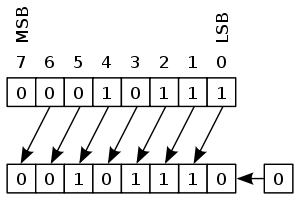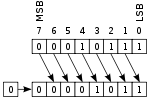
Logical shift
Encyclopedia
| Language | Left | Right |
|---|---|---|
| C C (programming language) C is a general-purpose computer programming language developed between 1969 and 1973 by Dennis Ritchie at the Bell Telephone Laboratories for use with the Unix operating system.... /C++ C++ C++ is a statically typed, free-form, multi-paradigm, compiled, general-purpose programming language. It is regarded as an intermediate-level language, as it comprises a combination of both high-level and low-level language features. It was developed by Bjarne Stroustrup starting in 1979 at Bell... /Go Go (programming language) Go is a compiled, garbage-collected, concurrent programming language developed by Google Inc.The initial design of Go was started in September 2007 by Robert Griesemer, Rob Pike, and Ken Thompson. Go was officially announced in November 2009. In May 2010, Rob Pike publicly stated that Go was being... (unsigned types only) |
<< | >> |
| Object Pascal Object Pascal Object Pascal refers to a branch of object-oriented derivatives of Pascal, mostly known as the primary programming language of Embarcadero Delphi.-Early history at Apple:... /Delphi Borland Delphi Embarcadero Delphi is an integrated development environment for console, desktop graphical, web, and mobile applications.Delphi's compilers use its own Object Pascal dialect of Pascal and generate native code for 32- and 64-bit Windows operating systems, as well as 32-bit Mac OS X and iOS... |
shl | shr |
| Java Java (programming language) Java is a programming language originally developed by James Gosling at Sun Microsystems and released in 1995 as a core component of Sun Microsystems' Java platform. The language derives much of its syntax from C and C++ but has a simpler object model and fewer low-level facilities... , JavaScript JavaScript JavaScript is a prototype-based scripting language that is dynamic, weakly typed and has first-class functions. It is a multi-paradigm language, supporting object-oriented, imperative, and functional programming styles.... , D D (programming language) The D programming language is an object-oriented, imperative, multi-paradigm, system programming language created by Walter Bright of Digital Mars. It originated as a re-engineering of C++, but even though it is mainly influenced by that language, it is not a variant of C++... |
<< | >>> |
| Ocaml | lsl | lsr |
| Standard ML Standard ML Standard ML is a general-purpose, modular, functional programming language with compile-time type checking and type inference. It is popular among compiler writers and programming language researchers, as well as in the development of theorem provers.SML is a modern descendant of the ML... |
<< | >> |
| Verilog Verilog In the semiconductor and electronic design industry, Verilog is a hardware description language used to model electronic systems. Verilog HDL, not to be confused with VHDL , is most commonly used in the design, verification, and implementation of digital logic chips at the register-transfer level... |
<< | >> |
| VHDL | sll | srl |
| Fortran Fortran Fortran is a general-purpose, procedural, imperative programming language that is especially suited to numeric computation and scientific computing... |
LSHIFT | RSHIFT |
In computer science
Computer science
Computer science or computing science is the study of the theoretical foundations of information and computation and of practical techniques for their implementation and application in computer systems...
, a logical shift is a bitwise operation
Bitwise operation
A bitwise operation operates on one or more bit patterns or binary numerals at the level of their individual bits. This is used directly at the digital hardware level as well as in microcode, machine code and certain kinds of high level languages...
that shifts all the bits of its operand. Unlike an arithmetic shift
Arithmetic shift
In computer programming, an arithmetic shift is a shift operator, sometimes known as a signed shift . For binary numbers it is a bitwise operation that shifts all of the bits of its operand; every bit in the operand is simply moved a given number of bit positions, and the vacant bit-positions are...
, a logical shift does not preserve a number's sign bit or distinguish a number's exponent from its mantissa
Mantissa
* The mantissa is the significand in a common logarithm or floating-point number.* Metaphorically, it is the part of the self that eludes conscious awareness or self-understanding.* An addition of little importance.Mantissa may also refer to:...
; every bit in the operand is simply moved a given number of bit positions, and the vacant bit-positions are filled in, generally with zeros (compare with a circular shift
Circular shift
In combinatorial mathematics, a circular shift is the operation of rearranging the entries in a tuple, either by moving the final entry to the first position, while shifting all other entries to the next position, or by performing the inverse operation...
).
A logical shift is often used when its operand is being treated as a sequence
Sequence
In mathematics, a sequence is an ordered list of objects . Like a set, it contains members , and the number of terms is called the length of the sequence. Unlike a set, order matters, and exactly the same elements can appear multiple times at different positions in the sequence...
of bits rather than as a number.
Logical shifts can be useful as efficient ways of performing multiplication or division of unsigned integers by powers of two. Shifting left by n bits on a signed or unsigned binary number has the effect of multiplying it by 2n. Shifting right by n bits on an unsigned binary number has the effect of dividing it by 2n (rounding towards 0).
Because arithmetic right shift differs from logical right shift, many languages have different operators
Operator (programming)
Programming languages typically support a set of operators: operations which differ from the language's functions in calling syntax and/or argument passing mode. Common examples that differ by syntax are mathematical arithmetic operations, e.g...
for them. For example, in Java
Java (programming language)
Java is a programming language originally developed by James Gosling at Sun Microsystems and released in 1995 as a core component of Sun Microsystems' Java platform. The language derives much of its syntax from C and C++ but has a simpler object model and fewer low-level facilities...
and JavaScript
JavaScript
JavaScript is a prototype-based scripting language that is dynamic, weakly typed and has first-class functions. It is a multi-paradigm language, supporting object-oriented, imperative, and functional programming styles....
, the arithmetic right shift operator is >>; whereas the logical right shift operator is >>>. (Java only has one left shift operator (<<), because arithmetic left shift and logical left shift have the same effect.)
The C
C (programming language)
C is a general-purpose computer programming language developed between 1969 and 1973 by Dennis Ritchie at the Bell Telephone Laboratories for use with the Unix operating system....
, C++
C++
C++ is a statically typed, free-form, multi-paradigm, compiled, general-purpose programming language. It is regarded as an intermediate-level language, as it comprises a combination of both high-level and low-level language features. It was developed by Bjarne Stroustrup starting in 1979 at Bell...
, and Go
Go (programming language)
Go is a compiled, garbage-collected, concurrent programming language developed by Google Inc.The initial design of Go was started in September 2007 by Robert Griesemer, Rob Pike, and Ken Thompson. Go was officially announced in November 2009. In May 2010, Rob Pike publicly stated that Go was being...
programming languages, however, have only one right shift operator, >>. Most C and C++ implementations, as well as the Go language, choose which right shift to perform depending on what type of integer is being shifted -- signed integers are shifted using the arithmetic shift, and unsigned integers are shifted using the logical shift.
Example
If the bit sequence 0001 0111 (decimal 23) were subjected to a logical shift of one bit position... (please refer to images below)- ...to the left would yield: 0010 1110 (decimal 46)

- ...to the right would yield: 0000 1011 (decimal 11)


